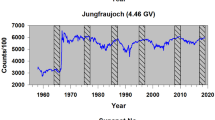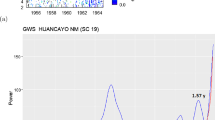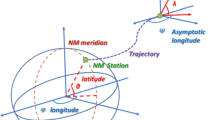Abstract
Neutron monitor counting rates and solar wind velocity, interplanetary magnetic field, sunspot number and total solar irradiance measurements from 2013 to 2018 corresponding to the end of solar maximum and the decreasing phase of the Solar Cycle 24 have been used. The main objective is to check whether the periodicities observed in the cosmic rays are affected by the magnetic rigidity or the height at which the neutron monitors are placed. A Global Neutron Monitor (GNM) has been defined as representative of the neutron monitor global network. This GNM is constructed by averaging the counting rates of a set of selected neutron monitors. The selection process is based on the combination of three new data quality criteria, which are applied to neutron monitors in the Neutron Monitor Data Base giving a final pool of 22 selected neutron monitors. Morlet wavelet analysis is applied to the GNM and the selected solar activity parameters to find the common periodicities. Short-term periodicities of 13.5, 27, 48, 92, 132 and 298 days have been observed in cosmic ray intensity. A clear inverse relationship between rigidity and spectral power has been obtained for the 13.5-, 48-, 92-, 132-day periods. A not so clear but still observed direct relationship between the height of the neutron monitors and the spectral power for the 48-, 92-, 132-day periods has been also found. The periodicity of 92 days is the one which shows the highest dependence with rigidity cutoff and height. As far as we know, this is the first time that these dependencies are reported. We think that these observations could be explained by assuming some cosmic ray intensity energy dependence in such periodicities and a competitive effect between rigidity and height.











Similar content being viewed by others
Abbreviations
- CR:
-
Cosmic Rays
- CRI:
-
Cosmic Rays Intensity
- HCS:
-
Heliospheric Current Sheet
- NM:
-
Neutron Monitor
- NMDB:
-
Neutron Monitor Database
- SC:
-
Solar Cycle
- TSI:
-
Total Solar Irradiance
- SSN:
-
Sunspot number
- WPS:
-
Wavelet Power Spectrum
- GWS:
-
Global Wavelet Spectrum
- GNM:
-
Global Neutron Monitor
- m.a.s.l.:
-
meters above sea level
- PCP:
-
Percentage of Corrected Points
- \(B\) :
-
module of interplanetary magnetic field
- \(B_{z}\) :
-
\(z\)-component in GSE (Geocentric Solar Ecliptic) coordinates of interplanetary magnetic field
- \(B_{r}\) :
-
parallel component to the ecliptic plane of interplanetary magnetic field
- \(V\) :
-
module of solar wind speed
- \(V_{x}\) :
-
\(x\)-component in GSE (Geocentric Solar Ecliptic) coordinates of solar wind speed
- \(V_{\mathrm{perp}}\) :
-
perpendicular component to the ecliptic plane of solar wind speed
References
Ahluwalia, H.: 2014, Sunspot activity and cosmic ray modulation at 1 a.u. for 1900–2013. Adv. Space Res.54, 1704. DOI.
Ahluwalia, H., Ygbuhay, R.: 2015, Cosmic ray 11-year modulation for sunspot cycle 24. Solar Phys.290, 635. DOI.
Bai, T.: 2003, Periodicities in solar flare occurrence: Analysis of cycles 19–23. Astrophys. J.591(1), 406. DOI.
Bazilevskaya, G., Krainev, M., Makhmutov, V.S.: 2000, Effects of cosmic rays on the Earth’s environment. J. Atmos. Solar-Terr. Phys.62, 1577. DOI.
Blanco, J.J., Catalán, E., Hidalgo, M.A., Medina, J., García, O., Rodríguez-Pacheco, J.: 2013, Observable effects of interplanetary coronal mass ejections on ground level neutron monitor count rates. Solar Phys.284, 167. DOI. ADS.
Chowdhury, P., Kudela, K.: 2018, Quasi-periodicities in cosmic rays and time lag with the solar activity at a middle latitude neutron monitor: 1982–2017. Astrophys. Space Sci.363, 250. DOI.
Chowdhury, P., Kudela, K., Moon, Y.-J.: 2016, A study of heliospheric modulation and periodicities of galactic cosmic rays during cycle 24. Solar Phys.291(2), 581. DOI.
El-Borie, M., Aly, N., El-Taher, A.: 2011, Midterm periodicities of cosmic ray intensities. J. Adv. Res.2, 137. DOI.
Forbush, S.E.: 1958, Cosmic-ray intensity variations during two solar cycles. J. Geophys. Res.63(4), 651. DOI. ADS.
Gnevyshev, M.N.: 1967, On the 11-years cycle of solar activity. Solar Phys.1, 17. DOI.
Grieder, P.: 2001, Cosmic Rays at Earth. Cosmic Rays at Earth by P.K.F. Grieder1, Elsevier, Amsterdam.
Joshi, B., Pant, P., Manoharan, P.: 2009, Periodicities in sunspot activity during solar cycle 23. Astron. Astrophys.452, 647. DOI.
Kopp, G.: 2016, Magnitudes and timescales of total solar irradiance variability. J. Space Weather Space Clim.6, A30. DOI.
Kudela, K., Rybák, J., Antalová, A., Storini, M.: 2002, Time evolution of low-frequency periodicities in cosmic ray intensity. Solar Phys.205, 165. DOI.
Kudela, K., Mavromichalaki, H., Papaioannou, A., Gerontidou, M.: 2010, On mid-term periodicities in cosmic rays. Solar Phys.266, 173. DOI.
Lean, J.L.: 2010, Cycles and trends in solar irradiance and climate. WIREs Clim. Change1(1), 111. DOI.
Mavromichalaki, H., Preka-Papadema, P., Petropoulos, B., Tsagouri, I., Georgakopoulos, S., Polygiannakis, J.: 2003a, Low- and high-frequency spectral behavior of cosmic-ray intensity for the period 1953–1996. Ann. Geophys.21(8), 1681. DOI.
Mavromichalaki, H., Preka-Papadema, P., Liritzis, I., Petropoulos, B., Kurt, V.: 2003b, Short-term variations of cosmic-ray intensity and flare related data in 1981-1983. New Astron.8, 777. DOI. ADS.
Nayar, S.R., Radhika, V.N., Revathy, K., Ramadas, V.: 2002, Wavelet analysis of solar, solar wind and geomagnetic parameters. Solar Phys.208, 359. DOI.
Oloketuyi, J., Liu, Y., Amanambu, A., Zhao, M.: 2020, Responses and periodic variations of cosmic ray intensity and solar wind speed to sunspot numbers. Adv. Astron.2020, 1. DOI.
Poblet, F., Azpilicueta, F.: 2018, 27-day variation in solar-terrestrial parameters: Global characteristics and an origin based approach of the signals. Adv. Space Res.61, 2275. DOI.
Potgieter, M.S.: 2008, Solar cycle variations and cosmic rays. J. Atmos. Solar-Terr. Phys.70(2), 207. DOI. Recent Observations and Simulations of the Sun-Earth System.
Potgieter, M.S.: 2013, Solar modulation of cosmic rays. Living Rev. Solar Phys.10(1), 3. DOI. ADS.
Rieger, E., Kanbach, G., Reppin, C., Share, G.H., Forrest, D.J., Chupp, E.L.: 1985, A 154-day periodicity in the occurrence of hard solar flares? Nature312, 623. DOI.
Roesch, A., Schmidbauer, H.: 2018. Waveletcomp: Computational wavelet analysis. R package version 1.1. https://CRAN.R-project.org/package=WaveletComp.
Ross, E., Chaplin, W.J.: 2019, The behaviour of galactic cosmic-ray intensity during solar activity cycle 24. Solar Phys.294(1), 8. DOI. ADS.
Saad Farid, A.I.: 2019, High frequency spectral features of galactic cosmic rays at different rigidities during the ascending and maximum phases of the solar cycle 24. Astrophys. Space Sci.364, 57. DOI.
Schreiber, H.: 1998, On the periodic variations of geomagnetic activity indices ap and ap. Ann. Geophys.16(5), 510. DOI.
Shea, M.A., Smart, D.F.: 2000, Fifty years of cosmic radiation data. Space Sci. Rev.93(1), 229. DOI.
Singh, S., Mishra, A.: 2018, Cosmic ray intensity increases during high solar activity period for the solar cycles 22 and 23. Indian J. Phys.93, 139. DOI.
Singh, P.R., Saxena, A.K., Tiwari, C.M.: 2018, Mid-term periodicities and heliospheric modulation of coronal index and solar flare index during solar cycles 22–23. J. Astrophys. Astron.39(2), 20. DOI.
Singh, M., Singh, Y., Badruddin: 2008, Solar modulation of galactic cosmic rays during the last five solar cycles. J. Atmos. Solar-Terr. Phys.70, 169. DOI.
Singh, P.R., Tiwari, C.M., Saxena, A.K., Agrawal, S.L., Mishra, A.P.: 2019, Mid-term periodicities in sunspot area of the Sun during solar cycles 22-24. Astrophys. Space Sci.364(4), 59. DOI. ADS
Torrence, C., Compo, G.P.: 1998, A practical guide to wavelet analysis. Bull. Am. Meteorol. Soc.79, 61. DOI.
Tsichla, M., Gerontidou, M., Mavromichalaki, H.: 2019, Spectral analysis of solar and geomagnetic parameters in relation to cosmic-ray intensity for the time period 1965 - 2018. Solar Phys.294, 15. DOI. ADS.
Tulasi Ram, S., Liu, C.H., Su, S.-Y.: 2010, Periodic solar wind forcing due to recurrent coronal holes during 1996–2009 and its impact on Earth’s geomagnetic and ionospheric properties during the extreme solar minimum. J. Geophys. Res.115(A12), A12340. DOI.
Usoskin, I.G., Kananen, H., Mursula, K., Tanskanen, P., Kovaltsov, G.A.: 1998, Correlative study of solar activity and cosmic ray intensity. J. Geophys. Res.103(A5), 9567. DOI. ADS.
Vipindas, V., Gopinath, S., Girish, T.E.: 2016, Periodicity analysis of galactic cosmic rays using Fourier, Hilbert, and higher-order spectral methods. Astrophys. Space Sci.361(4), 135. DOI.
Woods, T.N.: 2010, In: Cranmer, S.R., Hoeksema, J.T., Kohl, J.L. (eds.) Irradiance Variations During This Solar Cycle Minimum, Astronomical Society of the Pacific Conference Series428, 63. ADS.
Acknowledgements
Thanks to MINECO - FPI 2017 Program cofinanced by the European Social Fund. This work has been supported by the project CTM2016-77325-C2-1-P funded by Ministerio de Economía y Competitividad and by the European Regional Development Fund, FEDER. Data of neutron monitors has been downloaded from NMDB page: http://www.nmdb.eu/nest/. Athens neutron monitor data were kindly provided by the Physics Department of the National and Kapodistrian University of Athens. The neutron monitor data from Inuvik, Norm-Amberd, Newark, Peawanuck and Thule are provided by the University of Delaware Department of Physics and Astronomy and the Bartol Research Institute. The neutron monitor data from the South Pole Bares and South Pole are provided by the University of Wisconsin, River Falls. The neutron monitor data from Oulu are provided by Sodankyla Geophysical Observatory. Terra Adelie neutron monitor data were kindly provided by Observatoire de Paris and the French polar institute (IPEV), France. Mexico City neutron monitor data were kindly provided by the Cosmic Ray Group, Geophysical Institute, National Autonomous University of Mexico (UNAM), Mexico. Rome neutron monitor (SVIRCO NM) is supported by INAF/IAPS-UNIRoma3 COLLABORATION. Almaty Neutron Monitor data were kindly provided by the Institute of Ionosphere, Kazakhstan Potchefstroom and Hermanus Neutron Monitor data were kindly provided by the North-West University of South Africa. Jungfraujoch neutron monitor data were kindly provided by the Physikalisches Institut, University of Bern, Switzerland. Mirny Neutron Monitor data were kindly provided by Pushkov Institute of Terrestrial Magnetism, Ionosphere and radio wave propagation (IZMIRAN) of Russian Academy of Science. Apatity Neutron Monitor data were kindly provided by Polar Geophysical Institute Russian Academy of Sciences. Tixie-Bay and Yakutsk neutron monitor data were kindly provided by the Institute OF COSMOPHYSICAL RESEARCH AND AERONOIMY of Russian Academy of Science. CaLMa neutron monitor data were kindly provided by the Space Research Group (SRG-UAH), University of Alcala, Spain.
Author information
Authors and Affiliations
Corresponding authors
Ethics declarations
Disclosure of Potential Conflicts of Interest
The authors declare that they have no conflicts of interest.
Additional information
Publisher’s Note
Springer Nature remains neutral with regard to jurisdictional claims in published maps and institutional affiliations.
Appendix
Appendix
Rights and permissions
About this article
Cite this article
López-Comazzi, A., Blanco, J.J. Short-Term Periodicities Observed in Neutron Monitor Counting Rates. Sol Phys 295, 81 (2020). https://doi.org/10.1007/s11207-020-01649-5
Received:
Accepted:
Published:
DOI: https://doi.org/10.1007/s11207-020-01649-5










